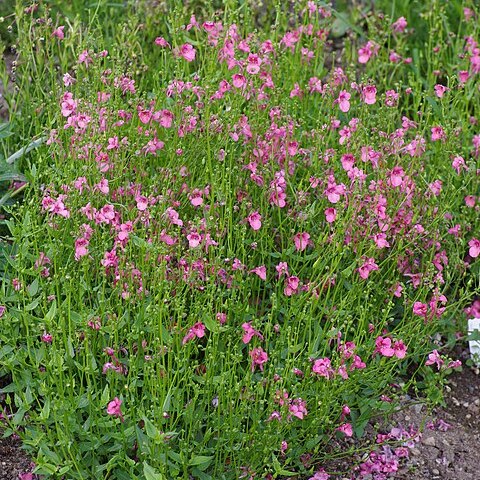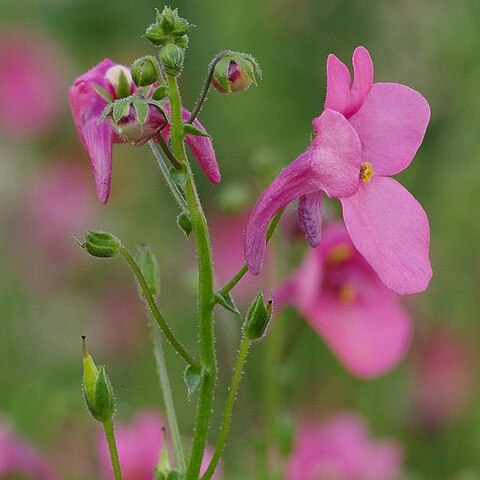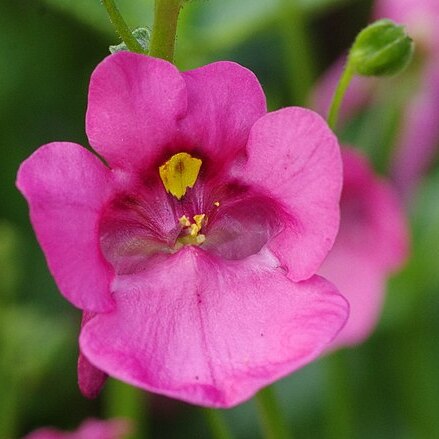Stoloniferous perennial herb, stems many from the crown, tufted, branching, up to 450 mm long, c. 2 mm diam., erect or decumbent, glabrous or nearly so becoming glandular-puberulous on the inflorescence branches. Leaves glabrous, mostly 10-25 x 5-20 mm (ratio 1-2:1), diminishing in size upwards, ovate or ovate-lanceolate, apex subacute, base somewhat rounded to almost truncate, margins serrate; petiole 1-5 mm long, the uppermost leaves nearly sessile. Flowers several to many in lax terminal racemes; bracts up to 6 x 4 mm, lanceolate, acute; pedicels mostly 11-30 mm long, ascending at an angle of c. 45°, glandular-puberulous, hairs scarcely 0.25 mm long, or sometimes wanting. Calyx segments lanceolate, two anticous ones c. 4 x 1.5 mm, three posticous ones slightly smaller, all green, thinly glandular-pilose or rarely glabrous. Corolla tube c. 5 mm long, shortly invaginated, two lateral spurs c. 7-8 mm long, directed out and down, tips slightly incurved, with a patch of dark sessile glands within; limb c. 23-27 x 20-24 mm, anticous lobe broadly ovate or subrotund, c. 11-13 x 13-16 mm, two lateral lobes ovate-oblong, c. 5-8 x 6-8 mm, two posticous lobes oblong-ovate, c. 4-7 x 4-6 mm, all lobes rose-pink, white patch at base of anticous lobe outside, all lobes thinly glandular-pilose outside, inside usually with two lateral patches of dark gland dots on the outer face of the palate and extending briefly onto the anticous lobe, very rarely these two patches linking up; “window” shallowly concave, the yellow portion fringed and blotched dark maroon. Stamens projecting forward from the base of the boss produced by the invaginated corolla tube; filaments c. 3.5 mm long, glandular-puberulous in upper part; anthers c. 0.5 mm long, cohering strongly, pollen yellow. Ovary c. 2 x 1.5 mm, deltoid in outline, ovules many in each loculus; style c. 2.5 mm long; stigma capitate, emerging from the centre of the anthers. Capsule c. 9-14 x 5 mm, urceolate; seeds c. 1.5 mm long, winged and ribbed.
More
Perennial herb with stolons, stems tufted, up to 500 mm high, erect or decumbent, ± glabrous, with some glandular hairs in inflorescence. Leaves ovate or ovate-lanceolate, ± acute; petioles up to 5 mm long to almost sessile upwards. Flowers: pedicels up to 30 mm long, ascending. Corolla: all lobes rose-pink, with white patch outside at base of lower lobe, inside on palate usually 2 lateral areas of dark glands, rarely these joined together; window somewhat hollow, yellow with maroon markings. Spurs lateral on tube, up to 8 mm long, projected out and down with tips a little curved inwards, with dark glands inside.
Perennial herb, 0.5-0.6 m high; stoloniferous. Stems erect or decumbent, sprawling; ± glabrous. Leaves petiolate to sessile; blade broadly ovate to narrowly ovate, 10-25 x 5-20 mm, apex ± acute, base obtuse, margins dentate; petioles up to 5 mm long. Flowers: in loose, leafy inflorescences; pedicels with hairs < 0.25 mm long; style ± 2.5 mm long; calyx reflexed; spurs conspicuously incurved, up to 8 mm long; corolla large, 16-24 x 12-16 mm, bright pink, window yellow marked maroon with 2 patches of dark glands on palate; Nov.-Mar.



